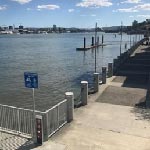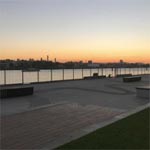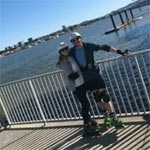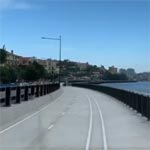| The most important part of selecting a skate is the fit. You may think that durability and looks are right up there, but if the skate doesn't fit properly you won't use it. Skates come in all shapes and sizes. Some are thin and have nothing more than a sock-like liner. Others see the value in comfortable liners and insert memory foam liners in their skates. Before you even put the skates on, you should look at the liner and feel all around it to see how good it is. There should be a little extra padding at the toe for those frequent crunches, and they may also offer custom inserts to better fit your foot. Regardless, skates should be thick and sturdy. |
| Basic Rules on looking for good quality and comfortable inline skates |
| There are some basic pointers to ensure a good fit. First is to know your foot size which can be determined during your Rollerblading Brisbane lesson. Your EUROPEAN (EURO) shoe size is a very handy measurement to know so check your favourite pair of runners / gym shoes before your lesson. Measure both feet since it is quite common to have one foot slightly larger. If so, you should probably get the larger size so that both are comfortable in the skate. Getting lessons saves you the financial burden of buying the wrong inline skates since many good skate schools can supply ex-rental skates and Rollerblading Brisbane encourages you to consider pre-owned skates from a sustainability perspective because there are plenty available. (Reduce, reuse, recycle) |
| Womens Recreational / Fitness Inline Skates |
| Women have a different foot shape than men that tends to have thinner heels, higher insteps, higher arch, and lower forefoot. A woman's forefoot often tends to spread a little more than a man's when weighted. Rollerblading Brisbane has inline skates (and rollerskates) available for lessons so provide your EUR shoe size is by either checking your sizing on our sizing chart or checking inside your favourite runners / gym shoes for the EUR size. If you are taking up inline skating in order to boost your fitness it is recommended that you get a skate-to-ski lesson. |
| Liner Types and socks |
| Liner types are also pretty important. Lace up liners tend to offer greater support and better fitting than normal stitched liners. Most inline skate liners can be removed for washing. Use 'odour eaters' to keep your liners and feet healthy! If you get blisters we recommend that you refrain from popping them! Instead you may wish to consider using hydrocolloidal pads such as the Compeed(TM) pads after washing and drying the affected area. Use socks with a sufficient length ie avoid low cut ankle socks. |
| Narrow Feet |
| Narrow feet are a different story. The easiest way to deal with them is to add pads in along the liner. Underneath, on the sides, wherever you can to make a good fit. And of course as in the wide foot scenario, you don't want to buy a narrower but shorter boot. Don't trade one uncomfortable aspect for another. |
| General looseness of skates |
If the skate length is fine, but the feel is just a bit loose, try lifting the foot by use of pads.
Back and forth looseness: If the skate is of a good fit, but tends to move back and forth, try adding a tongue pad in. This helps push the foot back and is good for solving problems like this.
Sensitive instep: Adding a pad in the tongue away from the sensitive spot tends to help relieve pressure.
Skates too wide: If it is just a little too wide, put a pad along the outside of the liner. If it is way too loose, put a pad both along the inside and outside.
Loose heel: A customised heel cushion could be helpful. You should place the pad inside the liner.
Pronation and supination: A heel wedge will help with support and stance in both cases. If it is a severe case, custom-fitted insoles may be needed. |
| Skate Types |
Knowing what type/s of skating you want to do is essential and can be discussed with your instructor.
Recreational / fitness inline skates tend to be lighter and have bigger / softer wheels. They can be further divided into soft-boot or hard boot skates. All good recreational skates feature a heel brake which can be easily replaced. For kids consider extendable skates.
Slalom / Freeride inline skates tend to be tighter than recreational skates and allow the rider to do tricks between cones. The brake is removed and skaters require a higher level of skill stopping. (Ask your instructor for more details).
Aggressive inline skates have smaller flattened wheels, a soul space and H-block designed for grinding and launching off ramps. They're built for strength. Their lower centre of gravity makes aggressive skates better for use in a skate park or on the city streets. For junior skaters, some manufacturers have combined the benefits of having an aggressive skate with a heel brake. The heel brake may be removed once the child is competent in using turns to control their speed and when having a brake may get in the way (e.g. on a half-pipe). (see Australian Rollerblading / Inline Skating Online Magazine (aka Rollerblading.com.au) for more information on Aggressive Inline Skating). Rollerblading Brisbane offers aggressive inline skating introductory lessons to proficient recreational skaters. Ask your instructor for more details.
Speed skates are often very light and have 3 or 4 wheels. The trend has definitely been towards lower numbers of wheel setups and larger wheel diameters! Ask your instructor for more details. We love speed skating! Just make sure you learn how to stop on rollerblades very well first! We would not recommend using speed skates for our lessons unless you have specifically requested (i.e. let your instructor know) about this. Note also that large wheels (eg 125mm) are quite expensive to replace.
Hockey skates are designed to allow skaters to turn faster often incorporating 'rockering' of the wheels and a detachable heel brake. Hockey skaters will often remove the heel brake from their skates so that it does not get in their way performing cross-over turns and hockey stops. We do not recommend that you use hockey skates for our beginner & intermediate level lessons because it is more cost effective as well as safer to use a fitted heel brake going down hills and our lessons encourage the use of heel brakes for safety reasons. |
| Skate Parts - wheels and bearings |
| Make sure that the bearings are sturdy (ABEC-1 to ABEC-5), and the skate has some sort of metal rockering spacers. Metal bearing spacers are also extremely important for speed and stability. Don't go spending too much extra money on wheels. Generally speaking, the larger the wheels - the more expensive they are to replace. There is an ample second hand marketplace for equipment including wheels. Just be aware that softer wheels wear down much faster. Remember to regularly turn over your wheels to ensure even wear. Your instructor can advise you on this. We look after our customers. |





